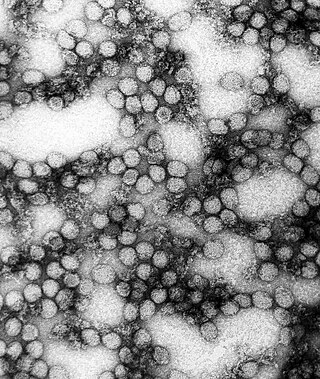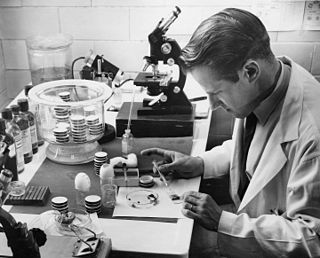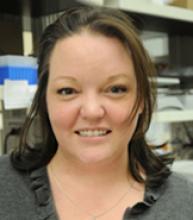
Flavivirus, renamed Orthoflavivirus in 2023, is a genus of positive-strand RNA viruses in the family Flaviviridae. The genus includes the West Nile virus, dengue virus, tick-borne encephalitis virus, yellow fever virus, Zika virus and several other viruses which may cause encephalitis, as well as insect-specific flaviviruses (ISFs) such as cell fusing agent virus (CFAV), Palm Creek virus (PCV), and Parramatta River virus (PaRV). While dual-host flaviviruses can infect vertebrates as well as arthropods, insect-specific flaviviruses are restricted to their competent arthropods. The means by which flaviviruses establish persistent infection in their competent vectors and cause disease in humans depends upon several virus-host interactions, including the intricate interplay between flavivirus-encoded immune antagonists and the host antiviral innate immune effector molecules.
The National Institute of Arthritis and Musculoskeletal and Skin Diseases (NIAMS) is one of the institutes and centers that make up the National Institutes of Health, an agency of the United States Department of Health and Human Services (HHS).
Viral pathogenesis is the study of the process and mechanisms by which viruses cause diseases in their target hosts, often at the cellular or molecular level. It is a specialized field of study in virology.
The Division of Acquired Immunodeficiency Syndrome (DAIDS) is a division of the National Institute of Allergy and Infectious Diseases, which is part of the National Institutes of Health. It was formed in 1986 as a part of the initiative to address the national research needs created by the advent and spread of the HIV/AIDS epidemic. Specifically, the Division's mission is to increase basic knowledge of the pathogenesis, natural history, and transmission of HIV disease and to support research that promotes progress in its detection, treatment, and prevention. DAIDS accomplishes this through planning, implementing, managing, and evaluating programs in (1) fundamental basic research, (2) discovery and development of therapies for HIV infection and its complications, and (3) discovery and development of vaccines and other prevention strategies.

Wilhelm Burgdorfer was a Swiss-American scientist and an international leader in the field of medical entomology. He discovered the bacterial pathogen that causes Lyme disease, a spirochete named Borrelia burgdorferi in his honor.

Myxoma virus is a poxvirus in the genus Leporipoxvirus. The two broad geographic types of myxoma virus are Californian and South American. Californian myxoma virus is found on the West Coast of the United States, the Baja Peninsula of Mexico, and the southwest coast of Canada. South American or Brazilian myxoma virus is found in South and Central America. South American myxoma virus circulates in the jungle rabbit or tapeti, whereas Californian myxoma virus circulates in the brush rabbit. In their native hosts, the viruses cause the formation of benign cutaneous fibromas rather than systemic disease.
Host tropism is the infection specificity of certain pathogens to particular hosts and host tissues. This explains why most pathogens are only capable of infecting a limited range of host organisms.

Rocky Mountain Laboratories (RML) is part of the NIH Intramural Research Program and is located in Hamilton, Montana. Operated by the National Institute of Allergy and Infectious Diseases, RML conducts research on maximum containment pathogens such as Ebola as well as research on prions and intracellular pathogens such as Coxiella burnetii and Francisella tularensis. RML operates one of the few Biosafety level 4 laboratories in the United States, as well as Biosafety level 3 and ABSL3/4 laboratories.

The Vaccine Research Center (VRC), is an intramural division of the National Institute of Allergy and Infectious Diseases (NIAID), part of the National Institutes of Health (NIH), US Department of Health and Human Services (HHS). The mission of the VRC is to discover and develop both vaccines and antibody-based products that target infectious diseases.
Alejandro Aballay is an American biologist, currently Professor and Chair of the Department of Molecular Microbiology & Immunology at Oregon Health & Science University. Aballay was Professor and the Director of the Center for Host-Microbial Interactions at Duke University School of Medicine until 2017. In 2013, he was elected to the American Association for the Advancement of Science.

Ann Linnea Sandberg was an American immunologist and the acting director of the Center for Integrative Craniofacial Research at the National Institute of Dental and Craniofacial Research (NIDCR). Previously, Sandberg was a lab chief and researcher for 23 years in the NIH Intramural Research Program at NIDCR.

Emmie de Wit is a Dutch-American virologist. She is chief of the molecular pathogenesis unit at the Rocky Mountain Laboratories. Her research combines pathogenesis studies with detailed molecular analyses to identify molecular determinants of severe respiratory tract disease within the virus and the host.

Andrea Marzi is a German-American virologist. She is chief of the immunobiology and molecular virology unit at the Rocky Mountain Laboratories. Marzi investigates the pathogenesis of filoviruses and vaccine development. She received the Loeffler-Frosch medal in recognition of her research.
Ya-Chi Ho is a Taiwanese infectious disease researcher and Associate Professor of Microbial Pathogenesis and Medicine at Yale University. Her research centers on the interaction between HIV and the host's immune system with the ultimate goal of curing HIV/AIDS.
Karen Louise Mossman is a Canadian virologist who is a professor of Pathology and Molecular Medicine at McMaster University. Mossman looks to understand how viruses get around the defence mechanisms of cells. She was part of a team of Canadian researchers who first isolated SARS-CoV-2.

Catharine "Katy" Mans Bosio is an American biologist. She is a senior investigator and chief of the immunity to pulmonary pathogens section at the National Institute of Allergy and Infectious Diseases.

Vanessa M. Hirsch is a Canadian-American veterinary pathologist and scientist. She is a senior investigator and chief of the nonhuman primate virology section at the National Institute of Allergy and Infectious Diseases. Hirsch researches AIDS pathogenesis, the evolution and origins of primate lentiviruses, and HIV vaccine development.

Niki M. Moutsopoulos is a Greek periodontist and immunologist. She is a senior investigator in the oral immunity and infection section at the National Institute of Dental and Craniofacial Research. Moutsopoulos specializes in oral immunology and periodontitis. Her research program focuses on host-microbial interactions that can drive chronic inflammatory responses and tissue destruction in the oral cavity.

Karen M. Frank is an American clinical pathologist and microbiologist researching the pathogenesis of Staphylococcus aureus pneumonia and resistant gram-negative bacteria. She is a senior clinician, principal investigator, and chief of laboratory medicine at the National Institutes of Health Clinical Center.
Flavivirus 3' UTR are untranslated regions in the genome of viruses in the genus Flavivirus.












